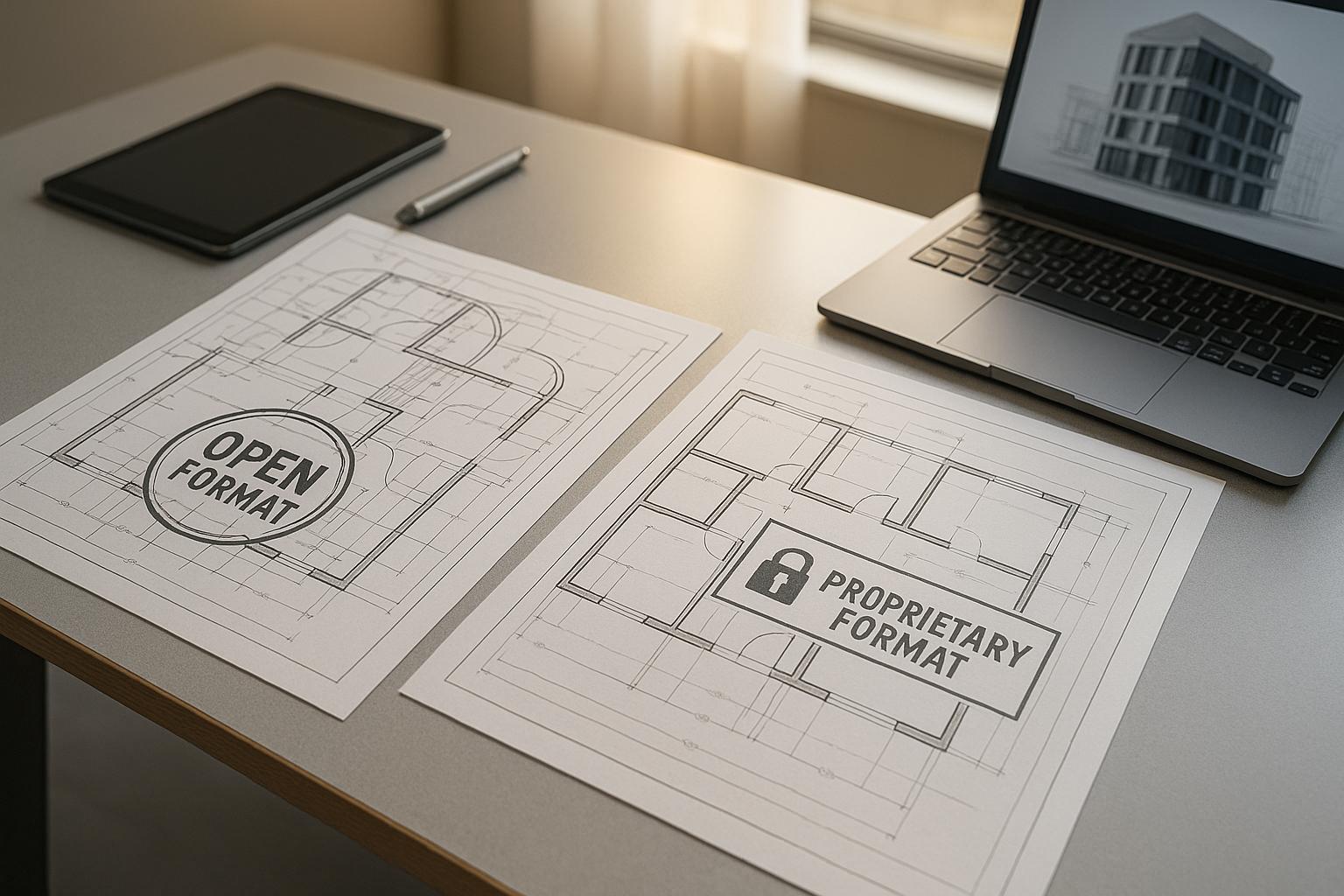Open vs Proprietary: The Long-Term Cost of Your BIM Data-Format Choice
Taher Pardawala June 30, 2025
Choosing the right BIM data format is a decision that impacts your costs, collaboration, and future technology use. Here’s the quick takeaway: Open BIM formats, like IFC, offer flexibility and interoperability across software, while proprietary formats lock you into a single vendor’s ecosystem. Open formats reduce long-term risks and costs but may require additional training and planning. Proprietary formats, on the other hand, provide smoother workflows within one system but can limit your options and increase expenses over time.
Key Points:
- Open BIM Formats (e.g., IFC): Promote collaboration, lower vendor dependency, and ensure data longevity. However, file sizes can be larger, and advanced software features may not transfer seamlessly.
- Proprietary Formats (e.g., .rvt, .dwg): Offer optimized performance within specific software but come with vendor lock-in, higher costs, and potential data migration challenges.
- Costs: Open formats often have lower upfront and long-term costs, while proprietary formats require higher licensing fees and may incur hidden expenses like data migration.
- Future-Proofing: Open formats align better with evolving technologies and standards, ensuring long-term usability of your data.
Quick Comparison:
| Aspect | Open BIM Formats | Proprietary Formats |
|---|---|---|
| Collaboration | Broad software support | Limited to vendor tools |
| Cost | Lower over time | High licensing fees |
| Flexibility | High vendor choice | Vendor lock-in |
| Data Longevity | Standards-based, durable | Risk of obsolescence |
| Training Needs | Requires learning IFC | Vendor-specific training |
Bottom Line: If you value flexibility and long-term cost control, open formats are a strong choice. Proprietary formats may suit projects needing specialized tools but come with higher costs and less freedom. Your decision should align with your business goals, team skills, and project needs.
Open BIM: The Only True Way to Future-Proof Collaboration
What Are Open BIM Data Formats
Open BIM formats are standardized file types designed to make building data exchange seamless across different software platforms. Among these, IFC (Industry Foundation Classes) stands out as the most commonly used format. Think of IFC as a universal translator for construction data, ensuring that various software tools can "speak the same language." This universal compatibility is the cornerstone of open BIM’s potential, as well as its challenges.
IFC allows professionals using different software to share and interpret building data without losing critical details. For example, an architect working in one program can send a model to an engineer using completely different software, and the data will remain intact.
buildingSMART International sums up the importance of this approach:
"Open BIM enhances the value of Building Information Modelling (BIM) by ensuring it conforms to a publicly available standardized communication language, which makes its information exchangeable and compatible with that of all stakeholders, even when in different locations, created by different organizations, and using different software tools." [5]
Currently, over 200 BIM tools are open BIM-compliant [3], covering a wide range of applications, including architecture, engineering, construction management, and facility management [2].
One of the standout features of open BIM formats like IFC is their ability to retain the relationships and properties of elements during data transfers. Unlike basic file conversions that might strip away important details, IFC files preserve the full depth of building information [2].
Benefits of Open BIM Formats
The core features of open BIM formats translate into several practical advantages. First, they promote cost efficiency and flexibility by removing dependency on specific software vendors. This independence helps teams avoid being locked into a single provider, protecting them from price increases or discontinued support.
Collaboration is another major plus. Open BIM ensures that all team members – regardless of the software they use – can access and work with the same data. This flexibility allows each team to choose tools that best suit their specific needs, while still contributing to a unified project model. The result? Smoother workflows and better project outcomes.
Transparency is also improved. Because open formats make data accessible and clear across platforms, communication among project stakeholders becomes easier [3]. When everyone works from the same source of truth, errors decrease, and decision-making becomes more efficient.
Another key advantage is long-term data sustainability. Open formats are based on widely accepted standards, ensuring that your building data remains usable even if a software vendor changes its business model or shuts down. This durability gives projects a level of future-proofing that proprietary formats often can’t match.
Ultimately, the interoperability offered by open BIM formats creates a collaborative digital space where teams can reduce the time spent on file conversions and avoid errors caused by data translation [2].
Limitations of Open BIM Formats
Despite their strengths, open BIM formats come with a few challenges. For example, data loss or errors can occur when transferring files between different software platforms, especially when dealing with complex geometries or highly specialized elements [6][1].
File size is another concern. IFC files are often 5–10 times larger than their native counterparts [2]. This can slow down file sharing and require more storage space, which might be inconvenient for some teams.
Additionally, not all software features translate well through open formats. Cutting-edge tools and advanced capabilities in proprietary software may not be fully supported by IFC, potentially limiting what you can do with your data [1].
Learning to use IFC effectively also requires additional training, as its complexity can lead to inconsistencies when interpreted by different software [1]. On top of that, managing file versions can be tricky. Without clear protocols, teams may struggle to ensure everyone is working with the most up-to-date data [1].
Fortunately, many of these issues can be addressed through careful planning, team training, and selecting certified IFC-compatible tools that support the latest format versions.
How Proprietary BIM Data Formats Work
Proprietary BIM formats are vendor-specific file types created by software companies to work exclusively within their own ecosystems [7]. Unlike open formats that aim for universal accessibility, proprietary formats are designed for tight integration with specific software, functioning only within their native applications.
These formats store data in ways that are only accessible via the software they originate from, making direct use in other tools impossible without some form of conversion [4]. This focused design offers both advantages and challenges, as we’ll explore below.
Many leading BIM software providers rely on proprietary formats. For instance, Autodesk Revit uses .rvt files to store building data, while AutoCAD employs the .dwg format for design and documentation [8]. Similarly, Tekla Structures uses .tbp and .tekla files for structural data, Allplan relies on .ndw and .npl files, and Archicad saves architectural models in .pln and .pla formats [8]. These formats are built for seamless operation within their respective software environments [7].
Benefits of Proprietary BIM Formats
Proprietary formats are optimized for their specific ecosystems, ensuring smooth performance and taking full advantage of vendor-specific features. For example, Revit’s .rvt files can store highly detailed building element data, which is particularly useful for handling complex geometries and specialized components [8].
Another key benefit is seamless workflow integration. When using tools from the same vendor, file compatibility issues are minimal, and data flows smoothly between applications. Additionally, because the vendor controls both the software and the file format, users often receive reliable technical support and regular updates tailored to their specific needs.
Problems with Proprietary BIM Formats
However, proprietary formats also come with significant drawbacks. One of the biggest issues is vendor lock-in, which limits flexibility and makes it difficult to switch to other solutions [9]. Collaboration can also be a challenge, as these formats restrict data sharing to those using the same vendor’s tools. When conversions are necessary to work with different software, information loss can occur [7].
Long-term access to data is another concern. If a vendor discontinues their software, changes their business model, or shuts down entirely, your ability to access and use your data could be jeopardized [7].
Licensing models tied to proprietary formats can further complicate things. Vendors often use a mix of perpetual and subscription-based licenses that may restrict how data is modified, shared, or distributed. These restrictions can lead to rising costs over time [9].
"If it’s your data, you should be able to open it, use it, reuse it, and connect it to whatever systems you choose – now and in the future." – BIM Business [10]
This quote highlights a core issue with proprietary formats: they can limit how you access, analyze, and connect your data over time. This restriction can hinder your ability to use building information for future projects or ongoing facility management. These challenges are critical to understanding the long-term costs associated with proprietary formats.
sbb-itb-51b9a02
Long-Term Costs: Open vs Proprietary Formats
Building on the earlier discussion of technical differences, let’s dive into how your choice of BIM format impacts finances over time. While proprietary formats often come with bundled licensing fees and open formats seem to offer lower upfront costs, the real picture is far more nuanced. Costs shift and evolve as your business scales, making it essential to understand the broader financial implications.
Main Cost Factors
One of the most obvious financial differences lies in software licensing. Proprietary BIM solutions often require annual licensing fees that can range from $50,000 to $100,000 for enterprise-level deployments [11]. These fees tend to increase over time as vendors introduce new features or adjust pricing structures.
On the other hand, open BIM formats can significantly lower these costs. Organizations using open-source tools have reported reducing development expenses by as much as 70% compared to proprietary solutions [11]. However, "open" doesn’t mean free – software tools supporting open standards like IFC still come with costs, but they typically offer more vendor options and competitive pricing.
Development and integration costs also vary significantly. Setting up a BIM platform can cost between $150,000 and $300,000 [11]. Proprietary formats often require specialized development skills and vendor-specific training, which can drive up costs. Open formats, however, allow more freedom in choosing tools and resources, providing flexibility that can help control expenses.
Infrastructure expenses add another layer to the financial equation. Traditional proprietary BIM setups might cost $20,000–$50,000 annually, but cloud-based solutions can reduce these costs by up to 30% [11]. Open formats often offer more deployment options, including cloud-based solutions, which can further optimize infrastructure spending.
Training and support costs are another key factor. Proprietary BIM software typically requires specialized training, which can be expensive [12]. In contrast, open BIM training tends to cost less due to widespread adoption of open standards and the availability of robust community support networks [12].
Hidden Costs and Business Risks
Beyond the obvious expenses, there are less visible but equally important costs to consider. For example, data conversion costs can become a financial burden when migrating to new systems or working with different software. Research from Gartner shows that 83% of data migration projects exceed budgets and schedules, with average overruns of 30% in cost and 41% in time [13].
Vendor dependency is another hidden cost. Proprietary formats can lock you into a specific vendor, reducing your ability to negotiate and often leading to escalating costs during contract renewals.
Limited interoperability is a common issue with proprietary formats, creating ongoing expenses over time. Achieving compatibility with other software often requires custom development, specialized plugins, or conversion services – costs that are largely avoidable with open standards [12].
Lastly, there are future-proofing risks. If a proprietary vendor changes strategy, discontinues support, or goes out of business, you could lose access to your data. Emergency data migration in such scenarios is far more expensive than a planned migration.
Cost Comparison: Open vs Proprietary Formats
A side-by-side comparison highlights the financial differences between open and proprietary BIM formats:
| Cost Category | Open BIM Formats | Proprietary Formats |
|---|---|---|
| Initial Licensing | $0 – $30,000 annually | $50,000 – $100,000 annually |
| Development Costs | Up to 70% lower than proprietary | $150,000 – $300,000 baseline |
| Infrastructure | Approximately 30% lower with cloud options | $20,000 – $50,000 annually |
| Training & Support | Lower due to community support | Higher due to specialized training |
| Data Migration | Minimal between compatible tools | High when switching vendors |
| Long-term Flexibility | High vendor choice | Limited to a single vendor |
The scale of your project also plays a role in costs. Pilot projects generally require an initial investment of $50,000 to $100,000 [11], with open BIM formats often sitting at the lower end of that range. For medium-sized platforms targeting niche markets, budgets typically range from $250,000 to $500,000 [11]. Enterprise-scale solutions for large construction firms can exceed $1 million in startup costs [11]. At this level, the potential 70% savings from open-source tools [11] can free up hundreds of thousands of dollars for custom development and integration.
Outsourcing is another area where open formats shine. Companies adopting open standards can save up to 25% by outsourcing certain tasks instead of maintaining full in-house teams [11]. This is largely due to the growing pool of service providers familiar with open standards.
Understanding these cost dynamics is key to aligning your BIM strategy with your project goals. While proprietary solutions may provide predictable short-term costs, open formats often offer better financial control and flexibility as your projects grow and data needs expand. These insights pave the way for making an informed decision on the right BIM format for your business.
Decision Guide: Choosing Your BIM Data Format
When it comes to choosing the right BIM data format, the decision goes beyond upfront costs. It’s about setting your business up for long-term success. Here’s a practical way to assess which option – open or proprietary – fits your needs.
Review Your Project Needs
Start by looking at how your projects operate. If your work involves multiple stakeholders using various software platforms, open BIM formats can be a game-changer. According to the National Institute of Standards and Testing (NIST), poor interoperability costs building owners a staggering $15.8 billion every year [15]. Clearly, seamless data sharing is more than a convenience – it’s a necessity.
Also, consider compliance with industry standards. Open BIM aligns with ISO 19650, which emphasizes quality and consistency in managing BIM workflows [6]. If meeting strict international standards is non-negotiable for you, this alignment becomes a key factor.
Think about how often you need to share data. Businesses that frequently exchange information with partners, contractors, or clients will find open formats especially useful for smooth data transfers.
Lastly, assess the complexity of your projects. Open BIM supports diverse and intricate documentation needs, enabling teams to work across various vendor platforms without being tied to a single proprietary system [6]. This versatility can help align your format choice with your broader business goals.
Match Formats to Business Goals
Your choice of format should directly support your company’s growth strategy. A survey shows that 75% of companies using BIM report positive returns on their investments [15]. However, the format you select will influence how easily you can scale these benefits.
If controlling costs is a priority, open formats offer flexibility by allowing you to work with a range of vendors. For example, strategic partnerships can reduce construction tech costs by up to 40%, while outsourcing certain tasks can cut expenses by about 25% compared to maintaining an in-house team [11]. Open formats make it easier to adopt these cost-saving strategies.
Taking the long view, open BIM ensures your digital assets remain usable and accessible for years to come by relying on open standards [6]. This is especially important for businesses that aim to maintain the value of their data over time.
If your focus includes facility management, standardizing data formats can greatly enhance outcomes. For instance, standardized data ensures that information from capital improvement projects is easily usable for maintenance, asset management, and other operational needs [14]. This approach can lead to better results in areas like sustainability, compliance, and space planning [14].
Choosing the right format involves weighing these benefits against your business goals. Once you’re clear on your objectives, the next step is to evaluate whether your technical setup can support the chosen format.
Check Your Technical Resources
Take a close look at your team’s expertise. Open BIM formats require knowledge of data exchange protocols and open standards like IFC and COBie [16]. On the other hand, proprietary formats may demand specific software licenses and skills within certain ecosystems. It’s important to be honest about your team’s capabilities and consider investing in training for BIM workflows and software integration [16].
Next, assess your infrastructure. Cloud-based solutions can reduce traditional infrastructure costs by about 30%, while remote work options can lower operational expenses by nearly 20% [11]. Open formats often offer more deployment flexibility, including cloud options that can optimize spending.
When it comes to software, think carefully about your selection criteria. Look at licensing costs, compatibility, and long-term hardware investments [16]. Open formats typically provide a wider range of vendor choices, which can be an advantage.
Finally, consider how well your processes are standardized. Regardless of the format, clear procedures for creating, managing, and sharing BIM data are essential [16]. Open formats can help maintain consistency across different platforms and vendor relationships.
Ultimately, the choice between open and proprietary formats depends on your specific situation. Open formats offer flexibility and cost control, while proprietary formats may provide specialized features but come with increased vendor reliance. By considering your team’s expertise, project demands, and long-term growth plans, you can make a decision that aligns with your business goals.
Conclusion: Making Smart BIM Format Decisions
When choosing a BIM data format, it’s essential to think beyond immediate project needs and consider the long-term impact on your business. The format you select will influence your operations for years, affecting everything from cost management to technical adaptability.
Businesses that value interoperability and flexible data management often achieve stronger long-term results. In this light, selecting formats that support seamless data sharing becomes more than a technical choice – it’s a strategic move.
Take a phased approach to manage complexity. Start by assessing your current BIM capabilities and identifying areas for improvement [17]. Instead of diving headfirst into one format, evaluate how different options align with your short-term project goals and your broader business strategy [18]. This gradual approach can help you mitigate risks while paving the way for smoother transitions.
Ensure your technical foundation is solid. A strong technical setup is just as important as having a clear business strategy. Define precise standards for BIM data creation, and invest in training your team on workflows, data exchange practices, and system integration [16]. This preparation ensures your team is equipped to handle the complexities of BIM implementation.
For startups, open formats often provide an edge due to their flexibility. They allow you to adapt your software tools and vendor partnerships as your business grows. On the other hand, proprietary formats, while offering specialized features, can lead to vendor lock-in, which may become expensive and restrictive over time.
Ultimately, your choice of BIM format should align with your business goals. If scalability, collaboration, and the ability to work across various software platforms are priorities, open formats are a strong foundation for growth. However, if your projects demand highly specialized tools in a controlled environment, proprietary formats might suit your needs – just be mindful of the long-term consequences of vendor dependency.
AlterSquare is here to guide you through these critical decisions. With deep expertise in MVP development and product engineering, we help startups align their technical choices with their business objectives. Whether you’re launching your first BIM-enabled project or upgrading existing systems, informed decisions about BIM formats can set the stage for sustainable growth in the construction tech space.
FAQs
What challenges come with using open BIM formats like IFC, and how can they be addressed?
Using open BIM formats like IFC isn’t without its hurdles. A frequent challenge is the risk of data loss or misinterpretation during file conversions, particularly with intricate designs. Another common obstacle is the limited compatibility between different software platforms, which can complicate collaboration for project teams.
To tackle these issues, sticking to best practices for data transfer and validation is crucial to minimize errors. Regular software updates and thorough interoperability testing can also make teamwork more efficient. Encouraging all team members to embrace and support open standards can go a long way in improving flexibility and reducing compatibility problems in the long run.
What are the long-term costs and risks of choosing open BIM formats versus proprietary ones?
Open BIM formats, such as IFC, tend to have lower long-term costs because they avoid licensing fees and reduce reliance on specific vendors. They also offer more flexibility and ensure your data remains accessible over time, which can help keep your projects relevant in the future. That said, you might encounter hidden expenses, like training your team, addressing compatibility issues, or managing interoperability challenges.
On the other hand, proprietary formats often provide seamless integration within their ecosystems but come with higher upfront costs and ongoing fees. They also pose risks, such as data becoming obsolete if the vendor stops supporting the format, potentially leading to costly data migration. Deciding between these options requires weighing your immediate priorities against the need for future adaptability and cost management.
Why might a business opt for proprietary BIM formats despite potential drawbacks like vendor lock-in and higher costs?
Some businesses opt for proprietary BIM formats when their projects demand specialized features, workflows, or integrations that open standards simply can’t deliver. These formats often come with advanced tools designed to address unique challenges, making them especially useful for complex or fast-paced projects.
Another factor influencing this choice is compatibility with existing systems or infrastructure. Reliable vendor support during critical stages can also play a big role in the decision-making process. While vendor lock-in and long-term costs are valid concerns, the immediate advantages of customized solutions and dependable performance can make proprietary formats the better option in specific situations.








Leave a Reply